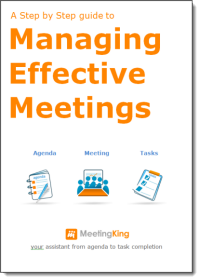How often have you found yourself back in the same meeting that you were in a few weeks ago discussing the same problems and having a strange sense of déjà vu? Unfortunately this is a very common problem that occurs with meetings, especially when tasks are not followed up on and no follow up meeting is held. These are mistakes commonly made in many organizations, and the good news is that they are very easy to correct.
Take Notes and Circulate Them
One of the easiest and most important activities that you can undertake in your meeting to make sure you don’t have to do your meeting over again in a couple of weeks is to take notes. Meeting notes (otherwise known as minutes) are a record of what was decided and what needs to be done. They do not have to be a verbatim transcription of everything that was said. It can be as simple as just listing the most important issues that were discussed, and critically, noting down the actions.
This may seem to be a bit of a pain, but it really does not have to be too onerous. As the meeting leader you do not necessarily have to do it yourself. You can assign it to a subordinate to do, so long as they understand the information that needs to be captured and can write clearly so that all can understand. MeetingKing offers a simple and easy solution for taking notes and assigning tasks during the meeting itself. The application will turn these short notes into a meeting minutes register that can be sent to all.
Taking notes on its own is insufficient. They need to also be circulated! If they are not sent to everyone that attended, participants do not have the opportunity to correct misunderstandings and are able to feign no knowledge of the meeting ever having happened. This happens more often in businesses than anyone would like to admit. Circulating the minutes is not just helpful for making sure a record of the meeting exists however, it also provides a checklist of what needs to be done that you can follow up on.
Following Up on Tasks
You might think that following up on tasks once the meeting minutes have been circulated would not be necessary, but it is. Each action on the minutes should have an assigned deadline, and it is recommendable that a few days prior to that deadline you call up the person responsible and check that everything is on track. This reminds them to do the task, or reminds them that you haven’t forgotten that they said they would do it. Either way it means that they are more likely to do the task by the deadline. Close the loop by making sure that you follow up with a reasonable level of frequency until the task is completed.
Holding Follow Up Meetings
Commonly, and especially during projects, there may be a need to hold follow up meetings. This could be so that individuals can report on progress achieved, or to discuss issues that have arisen when trying to complete actions. In this case the team can be brought together to brainstorm and decide what else needs to be done. Once again, the team minutes that you produced from your previous meeting become valuable. These can be used as the basis for a new meeting agenda. As a part of this you can run through tasks that were assigned at the previous meeting to make sure that they have been completed. MeetingKing offers a much-valued feature that assists meeting organisers to automatically create follow-up meetings. There is the ability to keep track of tasks that are completed and then to be able to run through the actual list of tasks still outstanding at the meeting.
Ultimately without double checking that meeting actions that were agreed are complete then the meeting is a waste of time. Make the most of your meetings by taking minutes, following up on those minutes and holding follow up meetings where needed to track actions and make sure your business is on track to meet its goals.


